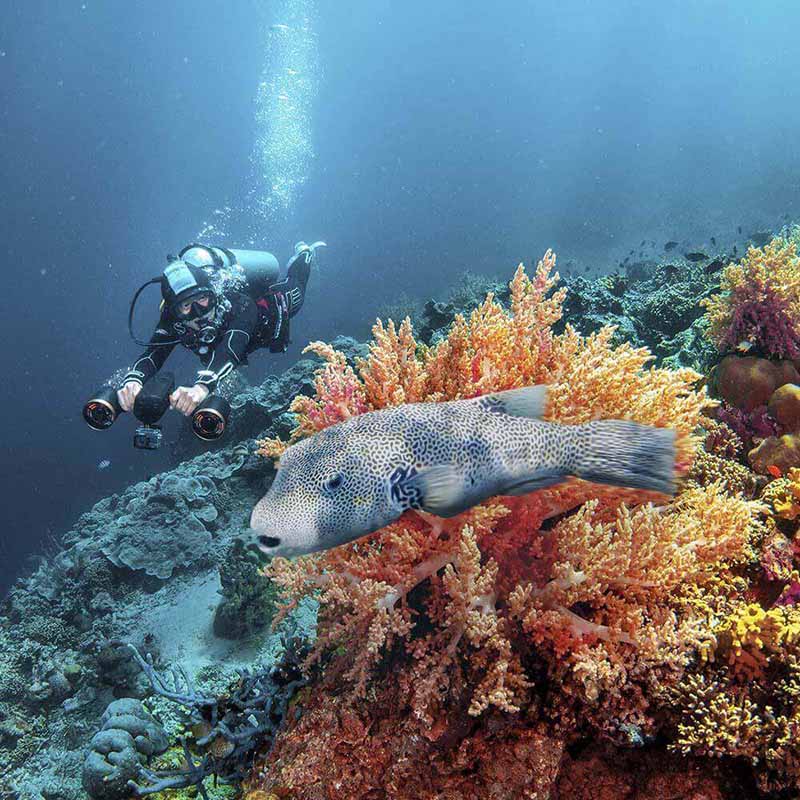Unleash Your Underwater Adventures: Discover the Ultimate Scooter Showdown!
Underwater scooters are making waves in the realms of water sports and marine exploration, rapidly gaining popularity among enthusiasts and adventure seekers. These innovative devices offer a thrilling way to glide through the depths of the ocean with ease and speed, transforming mundane snorkeling trips into exhilarating underwater escapades. The excitement of effortlessly exploring coral reefs or swimming alongside schools of fish has drawn many to consider adding an underwater scooter to their gear. However, with a variety of options available on the market, it becomes essential to carefully compare and evaluate different models to find the one that best suits individual needs and preferences. This article aims to guide you through the fascinating world of underwater scooters, providing insights into their functionality, key features, types, and user experiences, helping you make an informed decision on your next purchase.

Understanding Underwater Scooters
An underwater scooter, often referred to as a diver propulsion vehicle (DPV), is a compact, motorized device designed to assist divers and snorkelers in navigating underwater environments. These scooters work by propelling users through the water at varying speeds, allowing for extended exploration without exhausting physical exertion. Powered by rechargeable batteries, they can typically reach speeds of up to 3-5 mph, depending on the model. The benefits of using an underwater scooter are manifold; they not only enhance the exploration experience by allowing users to cover more distance with less effort but also provide an exhilarating thrill akin to riding a motorcycle underwater. For both recreational users looking to enjoy a day at the beach and professionals conducting underwater research or inspections, underwater scooters present an innovative solution to enhance efficiency and enjoyment in aquatic endeavors.
Key Features to Consider
When comparing underwater scooters, several key features should be taken into account to ensure the best choice for your needs. Battery life is paramount; look for scooters that offer extended usage times, ideally lasting several hours on a single charge. Speed is another critical factor; different scooters offer varying speeds, which can significantly impact your experience based on your skill level and intended use. Depth rating is crucial as well, especially for divers; ensure the scooter can handle the depths you plan to explore. Additionally, consider the weight capacity, as it should accommodate both the user and any gear being carried. Other features such as buoyancy control, ease of handling, and integrated safety features can also play a vital role in making your underwater adventures enjoyable and worry-free. Understanding these specifications will help you narrow down your options and choose a scooter that aligns with your underwater ambitions.
Types of Underwater Scooters
Underwater scooters come in various styles, each designed with specific functionalities to cater to different activities. Recreational scooters are typically lightweight and user-friendly, making them ideal for snorkeling and casual exploration. These models often have a lower speed and depth rating, perfect for beginners or those looking to enjoy a serene outing. Dive scooters, on the other hand, are engineered for deeper dives and more technical underwater activities, often featuring enhanced power and durability to withstand extreme conditions. There are also scooters designed for particular sports, such as underwater photography or spearfishing, which may include attachments or features tailored to those activities. Understanding the intended use of each type of scooter is essential for selecting the right model to match your underwater adventures.
Comparative Analysis of Popular Models
While specific brands and models vary widely, a general comparison of underwater scooters highlights several important specifications to consider. Many scooters offer a balance between performance and portability, making them suitable for both beginners and experienced divers. For instance, some models feature a lightweight design and a compact frame, allowing for easy transport and storage, while providing sufficient power for exhilarating rides. Others may boast advanced battery technology, enabling longer dive times and faster speeds, ideal for seasoned users aiming to explore more challenging environments. However, certain scooters may have limitations regarding depth ratings or weight capacity, which could affect their usability for different users. When evaluating these models, consider your skill level, planned usage, and personal preferences to identify the best fit for your underwater exploration needs.
User Experiences and Reviews
User feedback plays a significant role in understanding the practicality and performance of underwater scooters. Many users rave about the exhilarating experience these devices provide, often noting that they enhance the overall enjoyment of underwater activities by allowing for longer, more varied exploration. Common praises include the ease of use, impressive battery life, and the ability to glide effortlessly through the water. However, some users have raised concerns regarding the weight of certain models, which can be cumbersome during transportation. Additionally, a few complaints revolve around the need for regular maintenance and battery replacement, which can be slightly inconvenient. Overall, user experiences reflect a positive reception for underwater scooters, especially when users find models that align with their specific needs and preferences.
Making Informed Choices for Underwater Exploration
Choosing the right underwater scooter can significantly enhance your aquatic adventures, providing an exhilarating method to explore the underwater world. By understanding the different types of scooters available, their essential features, and the experiences of other users, you can make a well-informed decision that aligns with your specific needs and preferences. Whether you're a casual snorkeler or an experienced diver, the right underwater scooter can unlock a new realm of exploration and excitement beneath the waves. Remember to weigh your options carefully, and soon enough, you’ll be gliding through the water with ease, experiencing the beauty of the underwater landscape like never before.







